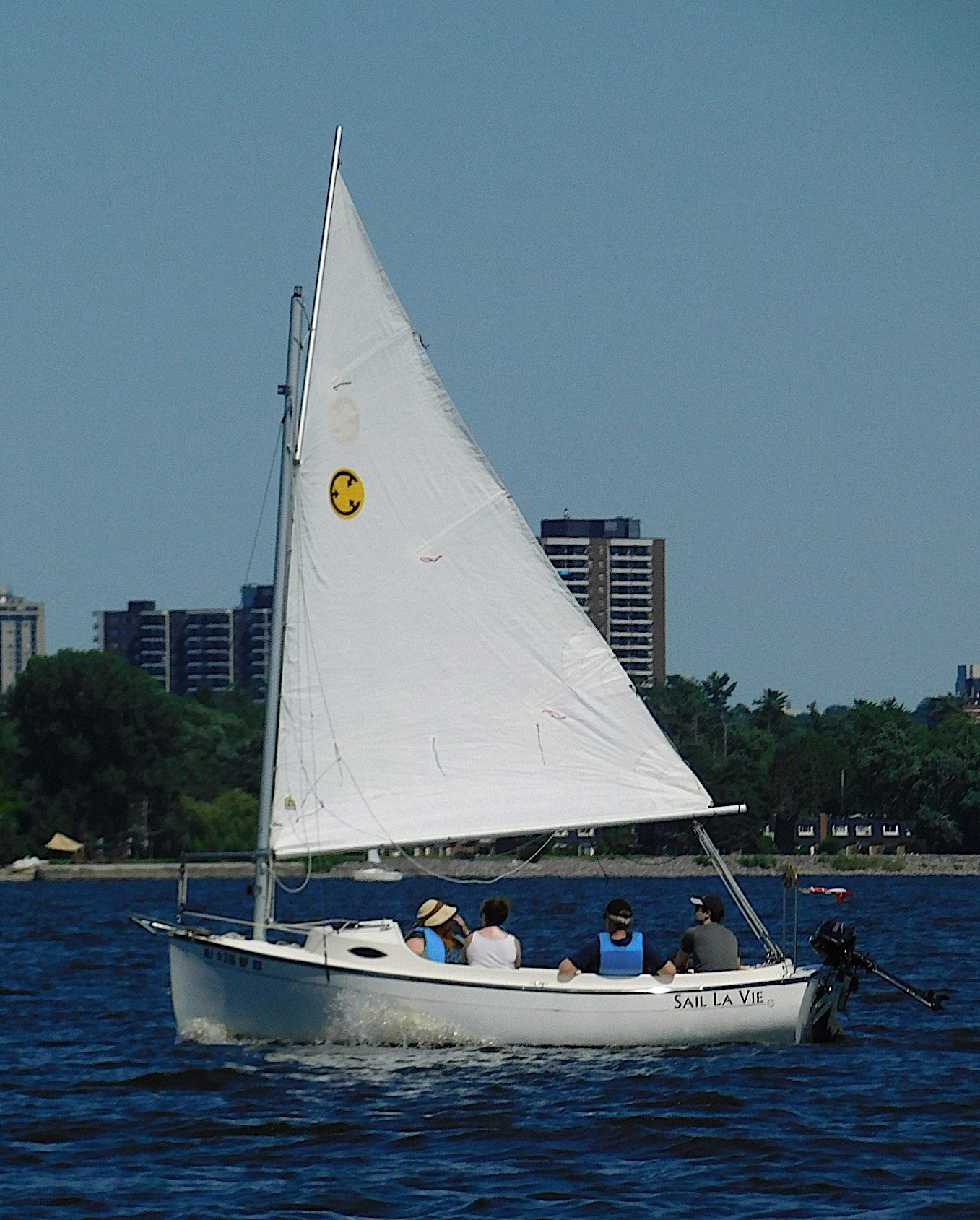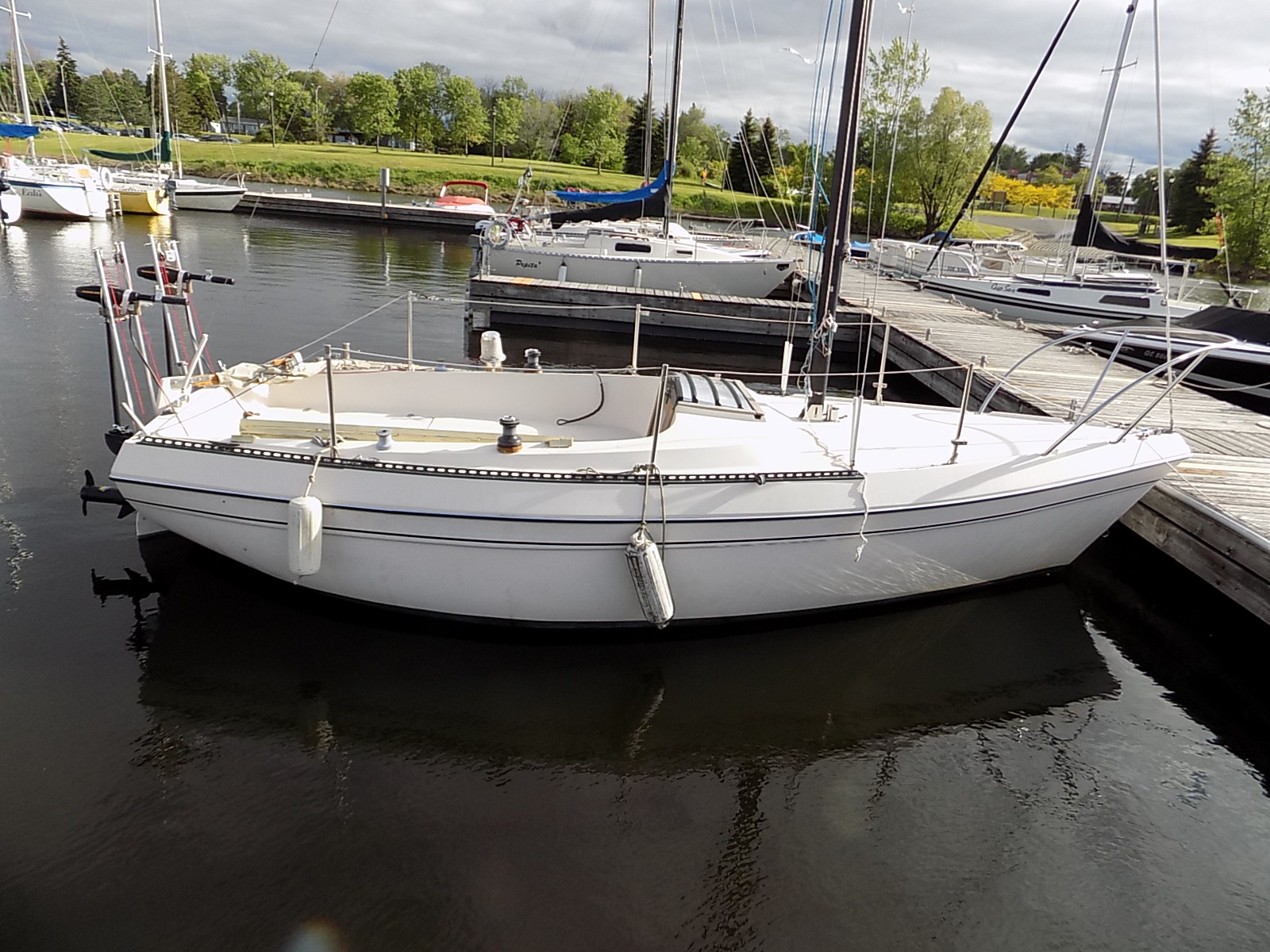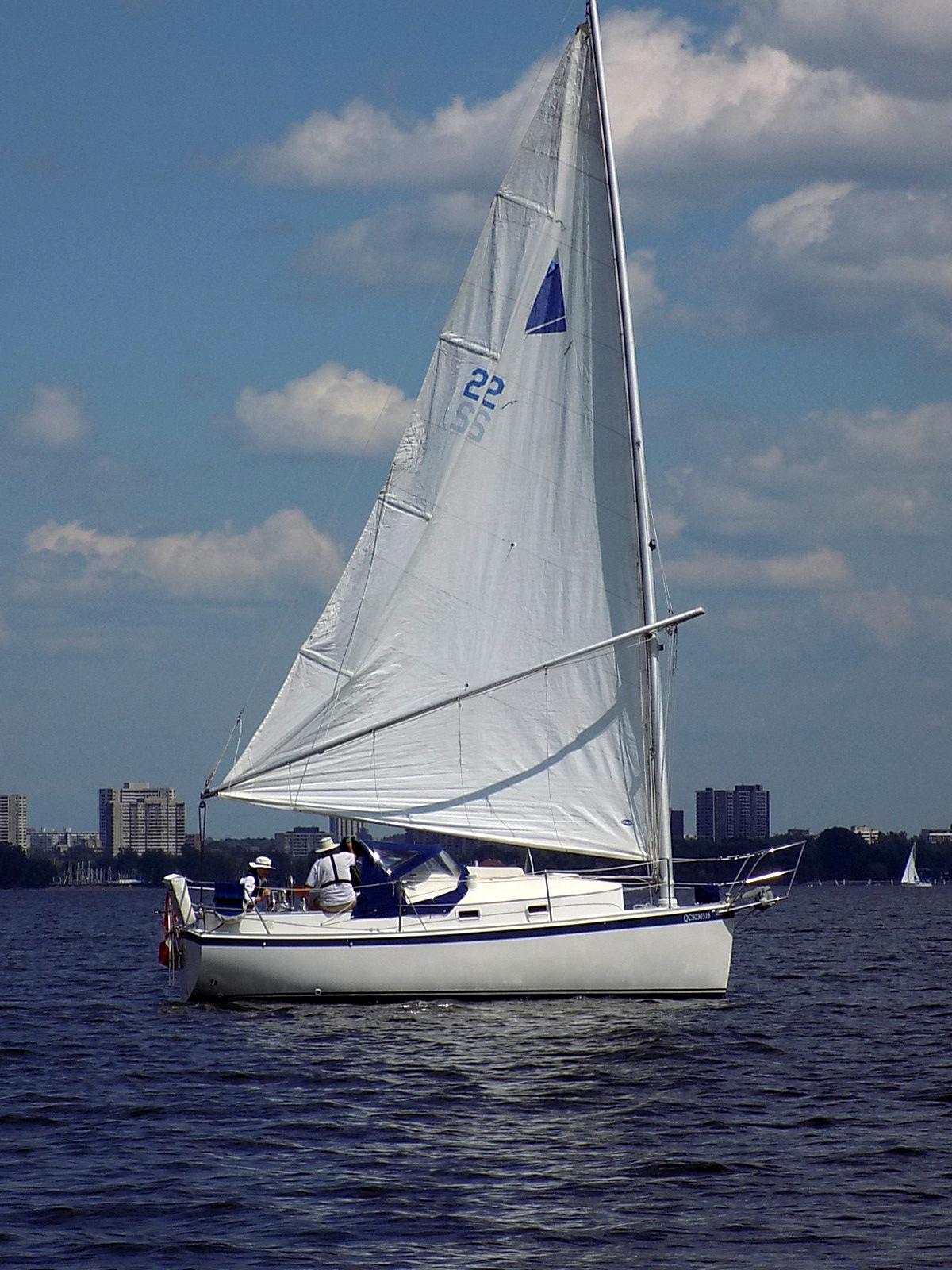|
Naiad 18
The Naiad 18 is a Canadian trailerable sailboat, that was designed by Mark Ellis, first built from 1984 to 1986, and named for the mythological water sprites. Production The boat was built by Luna Yachts in Oakville, Ontario, Canada, between 1984 and 1986, but it is now out of production. It is believed that 20 were completed. Although one was destroyed, by 2013, 19 remained in service. Design The Naiad 18 is a small, open, recreational keelboat, built predominantly of fiberglass, with wood trim. It has a cat rig, a plumb stem, a vertical transom, a transom-hung rudder, a wishbone boom and a centerboard that folds up into a trunk. It displaces and carries of ballast. The boat has a draft of with the centreboard extended and with it retracted, allowing beaching or ground transportation on a trailer. The boat can be optionally fitted with a small outboard motor for docking and maneuvering. The design has a hull speed of . See also *List of sailing boat types Rel ... [...More Info...] [...Related Items...] OR: [Wikipedia] [Google] [Baidu] |
Mark Ellis (yacht Designer)
Mark Ellis (born 4 February 1945) is an American-Canadian naval architect, who has designed sixteen production sailboats, along with many custom sailboats and powerboats. He is best known for his Nonsuch (sailboat), Nonsuch series of catboats, the Limestone series of powerboats and Niagara sailboats. In 2003, Dan Spurr described Ellis as "one of Canada's premier yacht designers". Ellis was born in Watertown, New York, United States. He currently lives in Oakville, Ontario, Canada and holds dual American citizenship and Canadian citizenship. Early life and education Ellis grew up in upstate New York (state), New York, where his father owned a department store. As a boy Ellis worked in the store and gained his first experience with business. He applied for a degree program in naval architecture at the University of Michigan but decided not to pursue it when he discovered that it mostly focused on large ship design, instead of small boats, which was where his interests lay. He went ... [...More Info...] [...Related Items...] OR: [Wikipedia] [Google] [Baidu] |
Cat Rig
A catboat (alternate spelling: cat boat) is a sailboat with a single sail on a single mast set well forward in the bow of a very beamy and (usually) shallow draft hull. Typically they are gaff rigged, though Bermuda rig is also used. Most are fitted with a centreboard, although some have a keel. The hull can be 12 to 40 feet long with a beam half as wide as the hull length at the waterline. The type is mainly found on that part of the Eastern seaboard of the USA from New Jersey to Massachusetts. Advantages of this sail plan include the economies derived from a rig with a limited number of component parts. It is quick to hoist sail and get underway. The cat rig sails well to windward, especially in calmer water. As a working boat, the forward mast placement gave ample room in the cockpit for fishing gear. Cruising versions can provide a large usable cabin space in a relatively short hull. Disadvantages of the rig include the limited deck space around the mast, which can be p ... [...More Info...] [...Related Items...] OR: [Wikipedia] [Google] [Baidu] |
Com-Pac Sunday Cat
The Com-Pac Sunday Cat is an American trailerable sailboat that was designed by Clark Mills, who had previously designed the Optimist. The Sunday Cat is a development of the Com-Pac Sun Cat. The Sun Cat comes in both cabin and open day sailer models. The Sunday Cat retains the large cockpit of the day sailer, but employs a small cuddy cabin that can accommodate a portable head. Production The design has been built by Com-Pac Yachts in the United States starting in about 2008 and remained in production in 2019. Design The Sunday Cat is a recreational keelboat, built predominantly of fiberglass. It has a cat rig with a single gaff-rigged sail, a plumb stem, a nearly vertical transom, a transom-hung rudder controlled by a wooden tiller and a stub keel, with a retractable stainless steel centerboard. It displaces and carries of fixed ballast. The boat has a draft of with the centreboard extended and with it retracted, allowing beaching or ground transportation on a ... [...More Info...] [...Related Items...] OR: [Wikipedia] [Google] [Baidu] |
Catalina 18
The Catalina 18, formerly known as the Capri 18, is a trailerable American sailboat that was designed by Frank Butler and Gerry Douglas and first built in 1985.Henkel, Steve: ''The Sailor's Book of Small Cruising Sailboats'', page 25. International Marine/McGraw-Hill, 2010. The design was originally marketed as the Capri 18, but the name was changed by the manufacturer to Catalina 18 in 2000. Production The design was built by Catalina Yachts in the United States, but it is now out of production. Design The Catalina 18 is a small recreational keelboat, built predominantly of fiberglass. It has a fractional sloop rig, a raked stem, a vertical transom, a transom-hung rudder controlled by a tiller and a fixed wing keel or fin keel. It displaces and carries of ballast. The boat has a draft of with the standard wing keel fitted or with fin keel. The wing keel was originally an option, but became standard equipment during the production run and the fin keel removed as ... [...More Info...] [...Related Items...] OR: [Wikipedia] [Google] [Baidu] |
Buccaneer 200
The Buccaneer 200 is an American trailerable sailboat, that was designed by Alan Payne and first built in 1974. The Buccaneer 200 is a development of the Columbia T-23 design, using the same tooling to build the hull. Production The boat was built by Bayliner Marine Corporation in the United States starting in 1974, but it is now out of production. Design The Buccaneer 200 is a small recreational keelboat, built predominantly of fiberglass, with wood trim. It has a masthead sloop rig, a transom-hung rudder and a fixed long shoal-draft keel. It displaces and carries of ballast.Henkel, Steve: ''The Sailor's Book of Small Cruising Sailboats'', page 87. International Marine/McGraw-Hill, 2010. The boat has a draft of with the standard keel, allowing beaching or ground transportation on a trailer. It is normally fitted with a small outboard motor for docking and maneuvering. The cabin is small but includes a double berth, a quarter berth, galley with a sink and a fold dow ... [...More Info...] [...Related Items...] OR: [Wikipedia] [Google] [Baidu] |
Nonsuch (sailboat)
The Nonsuch line of catboats is a series of popular cruising sailboats built between 1978 and the mid-1990s by Hinterhoeller Yachts in St. Catharines, Ontario. They are popular in North America, with over 950 boats built. The Nonsuch class was named after the ''Nonsuch'' that was the first trading vessel of Hudson's Bay Company, which in turn was named after the Baroness Nonsuch ( Barbara Palmer), a mistress of King Charles II of England. History In the mid-1970s, Gordon Fisher, a respected Canadian sailor, commissioned designer Mark Ellis to create a design for a cruising sailboat which would have decent accommodations, but still be easy for a singlehander to manage. Ellis designed a Ljungström rig, modified with a wishbone boom, on a 30-foot modern hull with a plumb bow, fin keel and balanced rudder. A beam of nearly 12 feet and cambered house-top created a large interior with accommodation equal to a standard yacht several feet longer. George Hinterhoeller, after som ... [...More Info...] [...Related Items...] OR: [Wikipedia] [Google] [Baidu] |
List Of Sailing Boat Types
The following is a partial list of sailboat types and sailing classes, including keelboats, dinghies and multihull ( catamarans and trimarans). Olympic classes World Sailing Classes Historically known as the IYRU (International Yacht Racing Union), the organization evolved into the ISAF (International Sailing Federation) in 1996, and as of December 2015 is now World Sailing. Dinghies Keelboats & yachts Multihulls Boards Radio-controlled Former World Sailing-classes Dinghies Keelboats & yachts Multihulls Boards Other classes and sailboat types Dinghies Keelboats & yachts Multihulls See also * Classic dinghy classes * List of boat types * List of historical ship types * List of keelboat classes designed before 1970 * Olympic sailing classes * Small-craft sailing * Clansman 30 Notes References {{DEFAULTSORT:Sailing boat types Types * Boat types A boat is a watercraft of a large range of types and sizes, but ge ... [...More Info...] [...Related Items...] OR: [Wikipedia] [Google] [Baidu] |
Hull Speed
Hull speed or displacement speed is the speed at which the wavelength of a vessel's bow wave is equal to the waterline length of the vessel. As boat speed increases from rest, the wavelength of the bow wave increases, and usually its crest-to-trough dimension (height) increases as well. When hull speed is exceeded, a vessel in displacement mode will appear to be climbing up the back of its bow wave. From a technical perspective, at hull speed the bow and stern waves interfere constructively, creating relatively large waves, and thus a relatively large value of wave drag. Ship drag for a displacement hull increases smoothly with speed as hull speed is approached and exceeded, often with no noticeable inflection at hull speed. The concept of hull speed is not used in modern naval architecture, where considerations of speed/length ratio or Froude number are considered more helpful. Background As a ship moves in the water, it creates standing waves that oppose its movement. T ... [...More Info...] [...Related Items...] OR: [Wikipedia] [Google] [Baidu] |
Outboard Motor
An outboard motor is a propulsion system for boats, consisting of a self-contained unit that includes engine, gearbox and propeller or jet drive, designed to be affixed to the outside of the transom. They are the most common motorised method of propelling small watercraft. As well as providing propulsion, outboards provide steering control, as they are designed to pivot over their mountings and thus control the direction of thrust. The skeg also acts as a rudder when the engine is not running. Unlike inboard motors, outboard motors can be easily removed for storage or repairs. In order to eliminate the chances of hitting bottom with an outboard motor, the motor can be tilted up to an elevated position either electronically or manually. This helps when traveling through shallow waters where there may be debris that could potentially damage the motor as well as the propeller. If the electric motor required to move the pistons which raise or lower the engine is malfunctioni ... [...More Info...] [...Related Items...] OR: [Wikipedia] [Google] [Baidu] |
Trailer (vehicle)
A trailer is an unpowered vehicle towed by a powered vehicle. It is commonly used for the transport of goods and materials. Sometimes recreational vehicles, travel trailers, or mobile homes with limited living facilities where people can camp or stay have been referred to as trailers. In earlier days, many such vehicles were towable trailers. United States In the United States, the term is sometimes used interchangeably with travel trailer and mobile home, varieties of trailers and manufactured housing designed for human habitation. Their origins lay in utility trailers built in a similar fashion to horse-drawn wagons. A trailer park is an area where mobile homes are placed for habitation. In the United States trailers ranging in size from single-axle dollies to 6-axle, high, long semi-trailers are commonplace. The latter, when towed as part of a tractor-trailer or "18-wheeler", carries a large percentage of the freight that travels over land in North America. Typ ... [...More Info...] [...Related Items...] OR: [Wikipedia] [Google] [Baidu] |
Beaching (nautical)
Beaching (or Landing) is the process in which a ship or boat is laid ashore, or grounded deliberately in shallow water. This is more usual with small flat-bottomed boats. Larger ships may be beached deliberately; for instance, in an emergency, a damaged ship might be beached to prevent it from sinking in deep water. Some vessels are designed to be loaded and unloaded by beaching; vessels of this type used by the military to disembark troops under fire are called landing craft. During the age of sail, vessels were sometimes beached to allow them to be rolled over for the hull to be maintained, a process called '' careening''. Ships scheduled for break-up are sometimes intentionally beached to make the procedure easier. See also * Landing craft * Shipwrecking Shipwrecking is an event that causes a shipwreck, such as a ship striking something that causes the ship A ship is a large watercraft that travels the world's oceans and other sufficiently deep waterways, carryi ... [...More Info...] [...Related Items...] OR: [Wikipedia] [Google] [Baidu] |
Centerboard
A centreboard or centerboard (US) is a retractable hull appendage which pivots out of a slot in the hull of a sailboat, known as a ''centreboard trunk'' (UK) or ''centerboard case'' (US). The retractability allows the centreboard to be raised to operate in shallow waters, to move the centre of lateral resistance (offsetting changes to the sailplan that move the centre of effort aft), to reduce drag when the full area of the centreboard is not needed, or when removing the boat from the water, as when trailering. A centreboard which consists of solely a pivoting metal plate is called a centerplate. A daggerboard is similar but slides vertically rather than pivoting. The analog in a scow is a bilgeboard: these are fitted in pairs and used one at a time. General History Lt. John Schank (c. 1740 – 6 February 1823) was an officer of the British Royal Navy and is credited with the invention of the centerboard. Schank, however, gave credit for the idea to British Brigadier General ... [...More Info...] [...Related Items...] OR: [Wikipedia] [Google] [Baidu] |

_-_Google_Art_Project.jpg)






